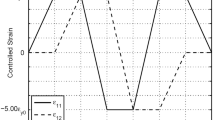Abstract
A mixed finite element (FE) and mesh-free (MF) method for gradient-dependent plasticity using linear complementarity theory is presented. The assumed displacement field is interpolated in terms of its discrete values defined at the nodal points of the FE mesh with the FE shape functions, whereas the assumed plastic multiplier field required to express its Laplacian is interpolated in terms of its discrete values defined at the integration points of the FE mesh with the MF interpolation functions. A standard form of linear complementarity problem is constructed by combining the weak form of momentum conservation equation and pointwise enforcements of both non-local constitutive equation and non-local yield criterion. The discrete values of the plastic multiplier are taken as the only primary unknowns to be determined. The numerical results demonstrate the validity of the proposed method in the simulation of the strain localization phenomenon due to strain softening.
Similar content being viewed by others
References
Bazant ZP, Belytschko T, Chang TP (1984) Continuum theory for strain softening. J Eng Mech-ASCE 110: 1666–1692
de Borst R (1989) Numerical methods for bifurcation analysis in geomechanics. Ingenieur-Archiv 59: 160–174
Needleman A (1988) Material rate dependence and mesh sensitivity in localization problems. Comput Methods Appl Mech Eng 67: 69–85
Eringen AC, Edelen DGB (1972) On non-local elasticity. Int J Eng Sci 10: 233–248
Mühlhaus HB (1989) Application of Cosserat theory in numerical solutions of limit load problems. Ingenieur-Archiv 59: 124–137
de Borst R (1991) Simulation of strain localization: a reappraisal of the Cosserat continuum. Eng Comput 8: 317–332
Fleck NA, Hutchinson JW (1993) A phenomenological theory for strain gradient effects in plasticity. J Mech Phys Solids 41: 1825–1857
Lasry D, Belytschko T (1988) Localization limiters in transient problems. Int J Solids Struct 24: 581–597
Aifantis EC (1984) On the microstructural origin of certain inelastic models. J Eng Mater Tech-ASME 106: 326–330
Aifantis EC (1987) The physics of plastic deformation. Int J Plasticity 3: 211–247
Mühlhaus HB, Aifantis EC (1991) A variational principle for gradient plasticity. Int J Solids Struct 28: 845–857
de Borst R, Mühlhaus HB (1992) Gradient-dependent plasticity: formulation and algorithmic aspects. Int J Numer Methods Eng 35: 521–539
Sluys LJ, de Borst R, Mühlhaus HB (1993) Wave propagation, localization and dispersion in a gradient-dependent medium. Int J Solids Struct 30: 1153–1171
Li XK, Cescotto S (1996) Finite element method for gradient plasticity at large strains. Int J Numer Methods Eng 39: 619–633
Pamin J, Askes H, de Borst R (2003) Two gradient plasticity theories discretized with the element-free Galerkin method. Comput Methods Appl Mech Eng 192: 2377–2403
Vernerey F, Liu WK, Moran B (2007) Multi-scale micromorphic theory for hierarchical materials. J Mech Phys Solids 55: 2603–2651
Liu WK, McVeigh C (2008) Predictive multiscale theory for design of heterogeneous materials. Comput Mech 42: 147–170
McVeigh C, Liu WK (2008) Linking microstructure and properties through a predictive multiresolution continuum. Comput Methods Appl Mech Eng 197: 3268–3290
Belytschko T, Liu WK, Moran B (2000) Nonlinear finite elements for continua and structures. Wiley, New York
Belytschko T, Krongauz Y, Organ D, Fleming M, Krysl P (1996) Meshless methods: an overview and recent developments. Comput Methods Appl Mech Eng 139: 3–47
Chen JS, Wu CT, Belytschko T (2000) Regularization of material instabilities by meshfree approximations with intrinsic length scales. Int J Numer Methods Eng 47: 1303–1322
Li S, Liu WK (2000) Numerical simulations of strain localization in inelastic solids using mesh-free methods. Int J Numer Methods Eng 48: 1285–1309
Zhang X, Yao ZH, Zhang ZF (2006) Application of MLPG in large deformation analysis. Acta Mech Sin 22: 331–340
Gu YT, Wang QX, Lam KY (2007) A meshless local Kriging method for large deformation analyses. Comput Methods Appl Mech Eng 196: 1673–1684
Belytschko T, Lu YY, Gu L (1994) Element-free Galerkin methods. Int J Numer Methods Eng 37: 229–256
Li SF, Liu WK, Rosakis AJ, Belytschko T, Hao W (2002) Mesh-free Galerkin simulations of dynamic shear band propagation and failure mode transition. Int J Solids Struct 39: 1213–1240
Chen JS, Zhang XW, Belytschko T (2004) An implicit gradient model by a reproducing kernel strain regularization in strain localization problems. Comput Methods Appl Mech Eng 193: 2827–2844
Manzari MT, Regueiro RA (2005) Gradient plasticity modeling of geomaterials in a meshfree environment. Part I: theory and variational formulation. Mech Res Commun 32: 536–546
Comi C, Perego U (1996) A generalized variable formulation for gradient dependent softening plasticity. Int J Numer Methods Eng 39: 3731–3755
Zhang HW, Schrefler BA (2000) Gradient-dependent plasticity model and dynamic strain localisation analysis of saturated and partially saturated porous media: one dimensional model. Eur J Mech A Solids 19: 503–524
Crisfield MA (1991) Non-linear finite element analysis of solids and structures, vol 1. Wiley, Chichester
Murty KG (1988) Linear complementarity, linear and nonlinear programming. Helderman-Verlag, Berlin
Zienkiewicz OC, Shiomi T (1984) Dynamic behaviour of saturated porous media: the generalized Biot formulation and its numerical solution. Int J Numer Anal Methods 8(1): 71–96
Lewis RW, Schrefler BA (1987) The finite element method in the deformation and consolidation of porous media. Wiley, Chichester
Andrade JE, Borja RI (2007) Modeling deformation banding in dense and loose fluid-saturated sands. Finite Elem Anal Des 43: 361–383
Author information
Authors and Affiliations
Corresponding author
Rights and permissions
About this article
Cite this article
Zhang, J., Li, X. A mixed finite element and mesh-free method using linear complementarity theory for gradient plasticity. Comput Mech 47, 171–185 (2011). https://doi.org/10.1007/s00466-010-0527-8
Received:
Accepted:
Published:
Issue Date:
DOI: https://doi.org/10.1007/s00466-010-0527-8




